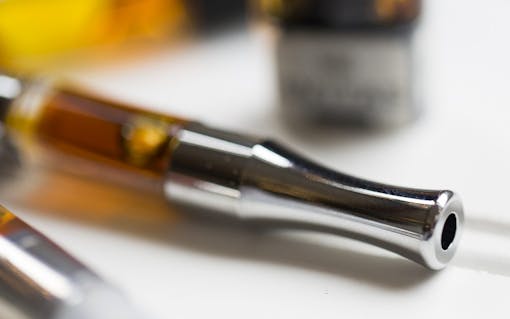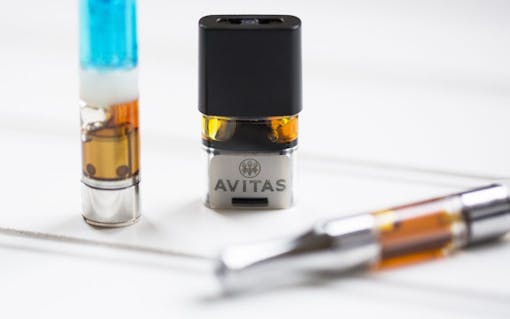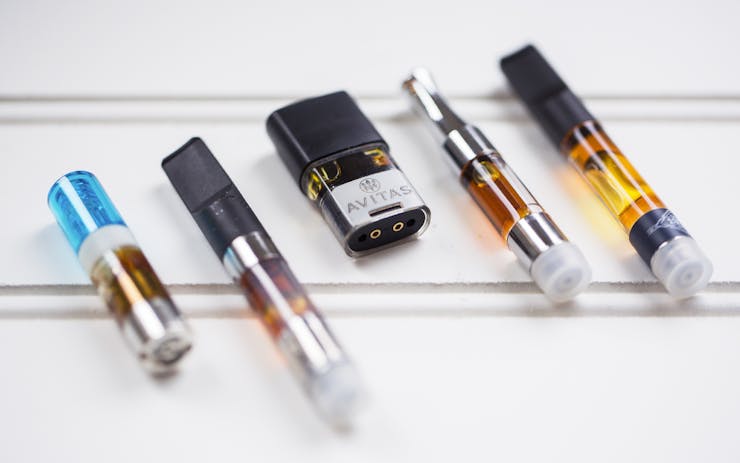Cannabis oil cartridges have undergone significant changes since their debut in legal cannabis markets. These small tankers sniped some of the technology and form factor from e-cigs/e-juice vapes and tailored their design and heat distribution to better suit cannabis oils. Early cartridge iterations can still be found in dispensaries alongside new technologies looking to disrupt the classic cartridge mold.
Over the years, I’ve gone through of dozens of different cartridges, each with wildly different compositions and constructions. I’ve seen firsthand the evolution of this segment of the cannabis industry dedicated to potency and convenience. So where did cannabis oil cartridges begin, and what will the future bring?
Browse Cannabis Oil Cartridges
As we journey through the timeline of cartridge history, keep in mind that the quality of cartridge material and construction is not indicative of oil quality. Finding the perfect synthesis of oil quality and cartridge construction is the sweet spot producers and processors reach for—some just get a little closer to the bullseye than others.
Plastic Wick Cartridges

(Julia Sumpter/Leafly)
The first type of vape cartridge I encountered was a plastic vessel with a plastic wick (c. 2013). This cartridge, made by O.pen, came with a little octagonal magnet with the strain name on it. The product was aesthetically alluring, but internally it had some flaws. At the time, the extracts were cut with PG (propylene glycol), a vaporizing agent used to improve viscosity and create bigger clouds. However, this oil would usually give me a headache after the first few rips. Quality of oil aside, the plastic cartridge and wick contributed to a less-than-enjoyable vaporizing experience.
Plastic cartridges are still being utilized by companies throughout adult-use cannabis markets, likely for their lower per-unit cost. These cartridges tend to impart the flavor of their materials to the vapor, especially after several long pulls and when the cartridge’s volume dwindles close to empty. The wick system was a logical option to stem the flow of oil while using technology that already existed, but the times are changing, and consumers are wising up to the value of glass and metal cartridges as they deliver better flavor.
Note: Some manufacturers will hide the wick behind or under a metal wrap around the cartridge. If it doesn’t have a vertical pipe at the center of the cartridge, chances are it’s using a wick.
Metal, Glass, and In-Line Pipe Cartridges

(Julia Sumpter/Leafly)
Glass and metal cartridges are quickly becoming the gold standard of cartridge design. These usually incorporate a standard atomizer, but materials can vary from cartridge to cartridge. Flavor clarity is the primary reason cannabis consumers prefer metal and glass cartridges over the plastic alternative. There’s also the risk of heating up less-than-inert substances like plastic, which we would rather not inhale.
Again, just because a cartridge is made out of metal and glass doesn’t necessarily mean the oil is better. A cartridge is a melding of biological and material sciences. Find a brand that makes quality oil and spends the extra scratch to package it in a higher-quality cartridge. These cartridges might be a little pricier, but as the use-case of metal and glass is backed by consumer dollars, the overall volume should go up and price per unit should go down. While this is partially conjecture, the empirical evidence in Washington has shown that several top-shelf brands have reduced the cost of full-gram glass and metal cartridges by $15-20 over the last couple of years.
Shop highly rated dispensaries near you
Showing you dispensaries nearPax Pods

(Julia Sumpter/Leafly)
Pax Pods break away from the traditional tubular cartridge form factor, but they still use similar materials like plastic and metal. The atomizer is often metal (or another inert material), which helps preserve flavor even near the end of the cartridge, but it’s not perfect yet. I still struggle to get the last slicks of oil to vaporize, and while temperature control is great (through the Pax app), I’m still leery when it comes to using less-than-inert materials like plastic at such high temperatures.
If Pax were to make a 1-gram metal and glass cartridge, I will personally buy those things ’til the cows come home (and between you and me, those cows ain’t coming back).
The Future of Cannabis Oil Cartridges
The struggle for a perfect cartridge continues to revolve around finding the perfect balance of quality cartridge materials, the viscosity and composition of oil, and ideal temperature. Some companies get closer to the mark than others, but just as Pax pushed cartridge design forward by changing it, it’s clear that the future of cartridges is still being invented.
If I had my druthers, I’d invent a standardized tanker that would attach to a mouthpiece and battery combo. The stem (mouthpiece) of this vape pen could be customized and maintained like traditional tobacco pipe stems, but it would connect to a battery that was as acute as the Pax Era’s own temperature control. Leakage and gunked-up mouthpieces are a problem that almost every cartridge suffers from, no matter the price range, and this would encourage consumers to clean and maintain their vaping kit while reducing the waste of disposable cartridges.
A standardized tanker would also empower concentrate manufactures to focus on creating great oil without fussing over whether or not it will work with the cartridge design or materials. Uniform tanker designs and power source parameters (outside of the variable voltage model of many current generation batteries) should help standardize tanker oil viscosity while still giving consumers the opportunity to customize the aesthetic of their vape pen.
This might be a pipe dream, but what I do know is that cartridges are improving, and that’s good news for everyone.





